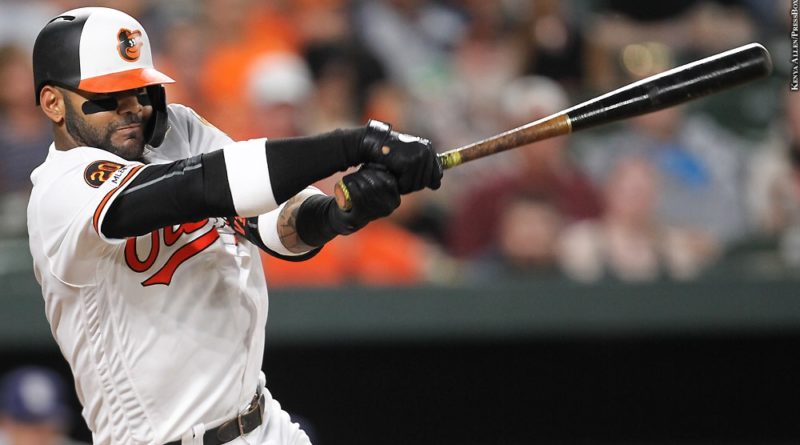Ever since mid-October, when MLB Trade Rumors released projected arbitration salaries for 2020, it’s been assumed that the Orioles would not want to pay infielder Jonathan Villar. That’s because, after hitting a career-high 24 home runs, stealing 40 bases and posting a 4.0 WAR season, his projected salary in his final year of arbitration surged north of $10 million.
General manager Mike Elias tried to trade Villar (and several others) before last season’s trade deadline with no success. Andrew Cashner was the only player the O’s dealt away; the club traded Cashner to the Boston Red Sox in exchange for two low-level prospects well before the deadline.
Unable to find a match for Villar, Elias decided to regroup in the offseason. Elias has made it clear multiple times that anyone on the O’s roster could be traded for the right price, and he seemed focused on moving some of the team’s arbitration-eligible players: Villar, Mychal Givens and Dylan Bundy, in particular.
“We have a large arbitration class,” Elias said in an interview earlier in the offseason. “There’s seven guys and they’re good players, but there is money involved. You’ve got to take it into consideration and it may influence the decision whether or not to tender a contract in the first place. But also your threshold for trading those guys if there’s interest elsewhere. That’s part of running any business and it’s part of reality. Money and budgets are a huge part of our business.”
On Nov. 27, after once again failing to find a trade partner, Elias made a business decision and reportedly placed Villar on outright waivers. Another team could claim Villar and tender him a contract (the deadline is Dec. 2), or he could go unclaimed and then almost certainly be non-tendered by the O’s. Villar could also stick around and negotiate a pre-arbitration deal, but the chances of that happening are doubtful at best.
In case you hadn’t heard, the Orioles are in Year Two of a full rebuild. There’s so much going on behind the scenes, and it all seems impressive and promising and long overdue. It’s not that hard to see how — after a handful of years of making significant gains in player development, scouting, analytics, technology, drafting and the international market — the O’s could contend for a playoff spot once again.
But there’s something that just feels weird about a team parting ways with its most productive position player from the previous season for two main reasons: 1.) Villar is projected to have a higher-than-desired salary for a single season, and 2.) The Orioles are going to be bad regardless.
It’s worth wondering what a team’s chief goal should be when it comes to salaries and payroll during a rebuild. Should a team slash as much payroll as possible and redirect everything into prospects, player development and infrastructure? Is it still worth trying to put maybe not a quality team, but perhaps a product on the field that’s still sort of fun? A team can play hard all it wants; it still needs some talent.
So the O’s don’t want to pay Villar around $10 million next season, and no other team may want to, either. Like all teams, the Orioles are working within a budget — so will that allocated money go to free-agent signings? Will it be funneled back into the organization? We won’t ever know, but it’s worth wondering.
It’s also worth noting that the Orioles have already been cutting payroll in a major way over the last few seasons. Here are the payrolls for their 25-man opening day rosters since 2017, courtesy of Cot’s Baseball Contracts:
2017: $164.3 million (10th)
2018: $148.5 million (13th)
2019: $80.2 million (27th)
2020: $72.8 million (26th) (projected with Villar included)
So what’s the argument for keeping Villar around, even with a bigger salary? Not only is he a good player who plays every day, but he’s fun! He hits for power, steals bases and finished as the highest-rated runner in FanGraphs’ baserunning metric. He provides a jolt to a team that doesn’t give fans much to get excited about. Fans don’t tune in just to see Villar, but he’s often a welcome source of entertainment.
Besides, the O’s tendering Villar a contract wouldn’t mean they’d have to keep him for the entire season. If he played at his 2019 level once again, another team could come calling around the trade deadline, especially with Villar only having around a half season of salary left and free agency approaching. There would be no guarantee, but it would be easier to deal him then.
General managers don’t need to remind fans that baseball is a business. Of course it’s a business — that fact is nearly impossible to escape at this point. Teams know that many fans will go along for the ride no matter what. In the Orioles’ case, what matters most is how effectively the rebuild progresses and how soon they’re able to win more baseball games.
In the meantime, though, the present still matters. The O’s are not in the market of winning right now, and you can understand why and that it will take some time. But there’s something to be said for picking and choosing spots to keep quality, enjoyable players around. With Elias in charge, the long-term outlook of the O’s still seems sunny, but the short term is still awful and now a little less fun.
Photo Credit: Kenya Allen/PressBox

